Technological applications on behalf of the elderly

This document includes the "Report 2. Monitoring Report" of the research proposal on ageing and longevity entitled: "Design, development and evaluation of a cognitive training platform using a Brain-Computer Interface system", the aim of which is to provide a tool for cognitive training of the elderly using neurofeedback techniques to halt the deterioration associated with normal ageing.
The document is organized as follows. To begin with, a follow-up is made on the objectives set, establishing the degree of compliance with them. Subsequently, the tasks carried out so far are listed, as well as the deliverables carried out and the results achieved in accordance with the work plan established in the project application. Finally, the final schedule is included according to the tasks and deliverables to be carried out in the following months.
Development of the proposed objectives
Below is a description of the degree of compliance with the specific objectives described in the project's technical report, indicating the percentage achieved.
O.E.1. Design and develop the BCI cognitive training platform
This objective has been fully met, as foreseen at the midpoint of the project according to the work plan included in the technical report. In the design and requirements capture phase, the neuropsychological functions to be trained with the cognitive training platform have been determined, as well as the electroencephalogram (EEG) signal processing methods to be used and the most appropriate visual feedback for each task. Regarding the development of the platform, the implementation of the user interface and the EEG signal processing methods to be used in the project has been completed, including algorithms for the frequency and spatial analysis of the EEG signal. The visual feedback applications of the platform have also been developed, consisting of 4 tasks.
O.E.2. Validating the BCI cognitive training platform
This objective has been met at 10%, exceeding the percentage initially estimated for this stage of the project. In order to bring forward the deadlines, the recruitment of volunteers for the evaluation of the platform has been started. The laboratory test group has been determined and will be made up of 10 healthy people under the age of 40. This group will allow the validation of the platform in the laboratory to correct errors through an iterative process and ensure the proper functioning of all software modules developed. Recruitment of the study population that will participate in the final evaluation of the platform has also begun. This population will be made up of at least 20 people over 60 years old. When the development of the platform is finished, the laboratory tests will be carried out with the corresponding group. Once all possible errors have been solved, the platform validation protocol will begin in the study population.
O.E.3. Disseminate results
This objective has not yet been addressed, as it is associated with the validation phase of the final cognitive training platform.
Tasks performed and results achieved
This section describes the scientific-technical tasks carried out to achieve the objectives set out in the project, the deliverables associated with them and the results achieved in each of them.
TASK 1. Design of the cognitive training platform (O.E.1)
Subtask 1.1. Design of the training methodology
The first sub-task was focused on identifying the neuropsychological functions to be trained with the platform. In order to be able to provide feedback to the user through the EEG that is related to each one of them, it is essential to carefully choose these functions according to the cortical areas that are activated when these functions are stimulated.
Currently, as a result of extensive research over the last century, there are several theories related to the specialization of different cortical zones. The theory of modularity, the successor to the old-fashioned phrenology, suggests that the brain is made up of specific regions that are highly specialized in different cognitive functions (Fodor 1983). On the other hand, the theory of distributed processing suggests that information is processed in a distributed manner among various parts of the cortex (McIntosh 1999). Recent studies based on graph theory, however, rely on a combination of both. Although complex cognitive processes are thought to involve the interaction of different parts of the brain, the scientific community assumes that certain regions are more specialized than others in particular functions (Bullmore and Sporns 2009). However, it should be noted that there is no clear consensus about the location of certain neuropsychological functions, and on numerous occasions the same area of the cortex is associated with several different neuropsychological abilities.
Several studies have shown that a greater synchronization of the activity of neurons located in specific regions of the cortex, reflected as an increase in the strength of the EEG signal, positively influences the associated functions, (Enriquez-Geppert, Huster, and Herrmann 2017). Therefore, the capabilities to be trained have been defined based on evidence from previous studies. The first three tasks will be oriented to the stimulation of three specific functions: memory, attention control, and conceptual activity (Cappelletti et al. 2009; Enriquez-Geppert et al. 2014, 2017; Hsueh et al. 2016; Ros et al. 2017; Scharnowski et al. 2012; Vernon et al. 2003; Zoefel, Huster, and Herrmann 2011). For each of these functions, a brain region and one or more frequency bands have been identified that the user must learn to modulate with the help of the feedback provided by the platform. The user's goal during training will be to increase the power of his or her EEG signal in the defined cortical region and bands. In addition, a fourth, more complex task is also included that covers several brain regions (i.e. frontal, central and temporal) and uses sensorimotor rhythms (SMR) for the control of a simple video game. In this task, the user must imagine the movements of his left and right hands, modulating their activity in contralateral areas of his brain (Wolpaw and Wolpaw 2012). This allows introducing a control with two degrees of freedom instead of one, increasing the complexity. This task has been shown to be effective in a previous study for the improvement of the general cognitive state, improving several neuropsychological functions at the same time (Gomez-Pilar et al. 2016). Table 1 specifies, for each of the 4 tasks, the target neuropsychological functions and the brain region and frequency bands involved.
Table 1. Selected neuropsychological functions to train with the developed platform. The user must modulate his brain activity endogenously in the area and bands corresponding to each function using the feedback provided.

Most previous studies only looked at the changes that neurofeedback-based cognitive training produced in the specific neuropsychological function being studied. However, there are clear indications that endogenous stimulation of a certain brain region could influence several abilities at the same time (Gomez-Pilar et al. 2016; Vernon et al. 2003). For this reason, in this project a complete neuropsychological analysis will be carried out before and after the training using the LURIA-DNA battery, one of the most prestigious and complete instruments for neuropsychological evaluation. This battery of tests systematically explores through a set of 9 tests the following abilities: visuospatial, language, memory, intellectual processes and attention.
Subtask 1.2. Visual Feedback Design
Once the neuropsychological functions to be trained have been decided, it is necessary to design the stimulation strategy that will be followed to train each one of them. To do this, 4 different tasks related to the 4 neuropsychological functions have been designed, in which the user will be offered real-time feedback that will reflect his or her own activity in the area and band chosen in Subtask 1.1. This information will be provided in a continuous, attractive and motivating way. In order for the user to learn how to modulate his brain activity in an endogenous way correctly, a different feedback has been designed for each task:
1. Memory. The first task will focus on stimulating the frontal region of the cortex, which largely regulates the user's short and long-term memory. A panel with different numbers will be offered, which will disappear a few seconds later. Subsequently, another panel will be offered to the user, where one of the numbers has been replaced by another. The user should try to remember which number has disappeared. The visual feedback will show the number to be remembered progressively with a fade in as the user generates the appropriate activity in the front area. This task has been designed to facilitate the generation of the appropriate activity in the frontal region while the user tries to remember the number. However, it is common for the user to find his own strategies to maintain his brain activity in the parameters determined as the training progresses, and thus manage to reveal the hidden number.
2. Attention control. The second task is focused on stimulating the alpha and beta bands in the central region of the cortex, located at the back of the frontal lobe, which regulates the user's attention and concentration. In this task a white sphere and a bar indicating a color gradient will be displayed. The user's objective will be to color the sphere completely. To do this, he will have to find the right strategies to stimulate the central region of his brain so that, when he increases the power in the alpha and beta bands, the sphere will gradually start to be tinted with the chosen color.
3. Conceptual activity. The third task will focus on training the user's conceptual abilities. It will show a cube perched on a table that will start to rise when the brain activity in the region and bands associated with this task is adequate. Therefore, the user's objective will be to learn how to control the cube and bring it to a certain height. To accomplish this, at first the user must imagine the cube from different perspectives (visuospatial skills), perform arithmetic operations or perform other activities related to abstract concepts, which have been shown to modify activity in the parietal zone of the cortex. However, as in the previous tasks, it is usual that users end up finding their own strategies to keep their activity within the defined parameters.
4. General training. The fourth task, focusing on the sensorimotor area of the cortex (i.e., posterior region of the frontal cortex and anterior region of the parietal cortex), will show an avatar on a pathway. On this occasion, the user will have to modulate his activity in the two cerebral hemispheres independently, which requires great concentration and mental effort. By imagining the movement of the right and left hands, the user will generate activity in the contralateral area of the cortex, making the avatar move. The objective will be to avoid the obstacles that appear on the way.
The graphic interface of each of the above tasks will be shown below, following the development of Task 2.
Likewise, the development of Task 1 has associated the deliverable 1.1. "Detailed report of the training methodology". In this report, all the above decisions were gathered: selection of neuropsychological functions to be delivered, location of the related activity on the cortex, selection of the target EEG frequencies, and the design of the visual feedback of the 4 tasks.
TASK 2. Development of the cognitive training platform (O.E.1)
Subtask 2.1. Development of the signal processing stages
The first sub-task of Task 2 was focused on developing the signal processing stages that will make up the cognitive training platform. These stages will monitor the user's EEG signal, pre-process it to eliminate external interference and noisy physiological artifacts, process it to detect brain activity in a particular area, and convert that activity into feedback for display to the user. The signal processing steps developed are outlined in Figure 1.
Signal processing consists of the following stages:
1. Recording of the EEG signal. A g.USBamp from the company g.Tec (Austria) with 16 active electrodes and a sampling frequency of 256 Hz will be used. Once the electrodes are placed in the positions indicated in Table 1, a harmless conductive gel is applied which promotes the reception of the EEG signal and reduces the air impedance of the contact between the electrodes and the scalp. It should be noted that the equipment is completely portable, since the signal is received through Bluetooth technology in a wireless way. The EEG signal will be received by the laptop, acquired through the Lab Streaming Layer (LSL) protocol.
2. Pre-processing of the EEG signal A high-pass filter with a cut-off frequency of 0.5 Hz shall be applied to remove the continuous component of the EEG signal and a common average reference space (CAR) filter shall be applied to increase the signal-to-noise ratio, reduce the spatial blurring of the electrodes and remove artifacts from the signal.
3. Signal processing. In this step the EEG power at the specified cortical location and bands shall be calculated. For this purpose: (i) select the EEG channels associated with each neuropsychological function (Table 1, column 3); (ii) filter the frequency bands of interest by means of a bandpass filter (Table 1, column 4); (iii) calculate the signal power; (iv) and send it to the visual feedback application, allowing its control in real time.
The previously mentioned algorithms have been integrated within the platform developed for the analysis of the EEG signal in real time. This platform has been developed in Python, a multiplatform language that has a large number of libraries that facilitate the development task. Specifically, it has support for Qt, one of the most widely used graphic interface development frameworks today. This library has been used to develop the main user interface, which allows the control of the neurofeedback application, the real-time temporal and frequency representation of the EEG signal and the selection of the training parameters in an easy and intuitive way. Figure 2 shows a screenshot of the user interface of the developed cognitive training platform. The signal processing module has also been developed in Python, which facilitates its integration into the overall workflow of the platform. Additionally, there are many libraries, such as numpy or scipy, that allow matrix calculations and include functions for the design of filters that facilitate the implementation of the signal processing methods described in the previous point.
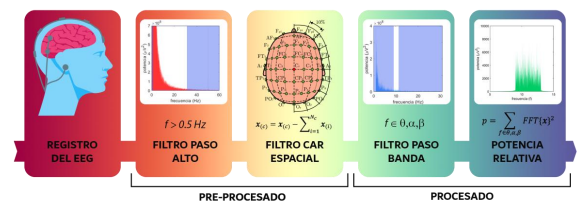
Figure 1. Diagram of the signal processing developed. To begin with, the user's EEG is recorded by means of a device with 16 active channels. Then, the signal is pre-processed by removing artifacts and interference through spatial and frequency filtering. To quantify the user activity in a localized area of the cortex and in a specific frequency band, the signal is filtered again and the relative power of the signal in the filtered band is found.
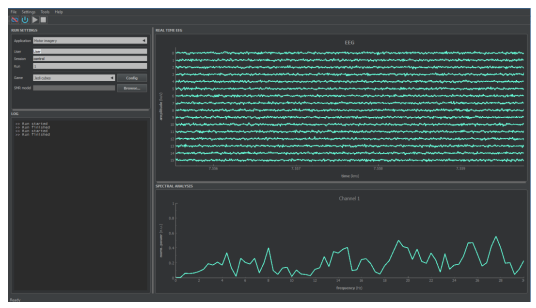
Figure 2. Graphical interface of the cognitive training platform The training parameters are selected in the left panel. On the right side the EEG signal is represented in the temporal and frequency domains.
Likewise, the development of the subtask 2.1. has associated the deliverable 2.1. "Report with the technical characteristics of the developed platform". This report includes all the characteristics previously mentioned: programming languages, registration protocol, EEG registration equipment, signal pre-processing stage, and signal processing stage.
Subtask 2.1. Development of visual feedback applications
The second sub-task of Task 2 was focused on developing the visual feedback applications that will make up the 4 tasks to be performed by the user.
The visual feedback module has been developed in Unity, one of the most used graphic development environments nowadays. Like Python, Unity is a multiplatform environment, which ensures the operation of the platform in the most common operating systems (e.g., Windows, Linux, Mac). The applications developed, therefore, receive the power of the EEG signal in the cortical regions and bands specified by the signal processing module (Figure 1), and act accordingly. Figures 3-6 show screenshots of the 4 applications developed, whose operation has been previously detailed during subtask 1.2.
Likewise, the development of subtask 2.2 has the deliverable 2.2 "BCI cognitive training platform" associated to it. Given that all the stages of the platform have been developed, there is currently a prototype of the same, which must be evaluated with the laboratory group to detect possible errors and implement suggestions for improvement. Finally, the final prototype will be evaluated with the study population.
TASK 3. Evaluation of the cognitive training platform (O.E.3)
As originally specified in the proposal, the platform evaluation protocol consists of three stages (Figure 7):
1. Neuropsychological evaluation by a specialist using the LURIA-DNA test and initial baseline EEG records to the entire study population.
2. The population is divided into two subgroups. One of the subgroups will not use the cognitive training platform, while the other will perform 8 training sessions of approximately one and a half hours.
3. Neuropsychological evaluation by a specialist using the LURIA-DNA test and final baseline EEG records to the entire study population.
This task was originally planned between months 7-9. However, since the project currently lasts 10 months, the laboratory control group has already been recruited to perform the appropriate tests before the final evaluation; and recruitment of the study population (people over 60 years old) has begun.
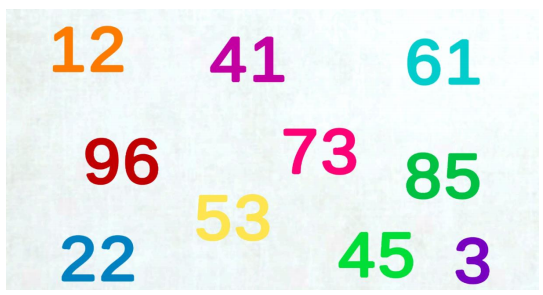
Figure 3. Visual feedback of the first task, where the frontal region in the theta and alpha bands will be stimulated. It will show several numbers for a few seconds. Later, one number will be changed for another, and the user must remember which one it is. If the user maintains his brain activity within the determined parameters, the number will be revealed little by little. 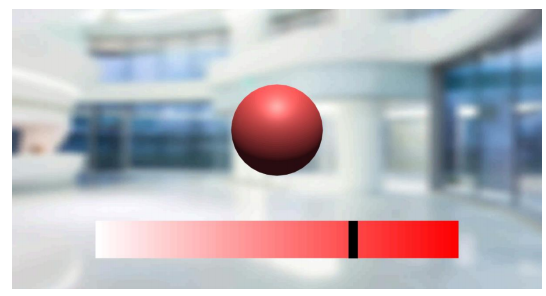
Figure 4. Visual feedback of the second task, where the central region in the alpha and beta bands will be stimulated. When the EEG power exceeds a certain threshold, the sphere, which is initially white, will progressively turn red. The higher the power, the faster the color changes.
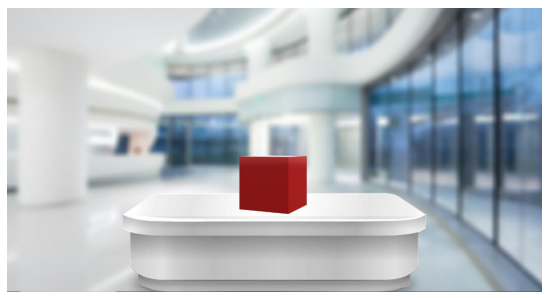
Figure 5. Visual feedback of the third task, where the parietal region in the alpha band will be stimulated, associated with the conceptual activity. When the EEG power exceeds a certain threshold, the cube will rise and begin to rotate. The higher the power, the higher the speed of travel.
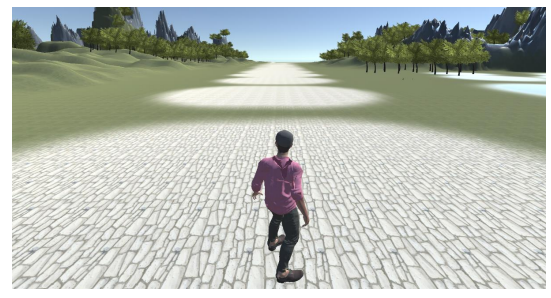
Figure 6. Visual feedback of the fourth task. In this task, the avatar moves along the path, where obstacles appear randomly. The user's objective is to avoid the obstacles by modulating his brain activity in the two contralateral hemispheres separately. When the power of the EEG is higher in the right hemisphere, the avatar moves to the left; and vice versa. The introduction of two degrees of freedom increases the complexity of the task.
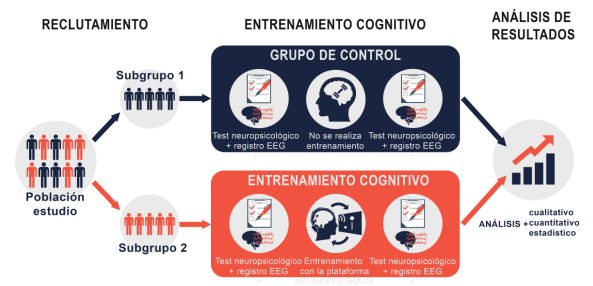
Figure 7. Validation protocol of the cognitive training platform.
Subtask 3.1. Recruitment of the study population
The first sub-task of Task 3 is focused on recruiting the study population that will evaluate the cognitive training platform.
So far, a control group of 10 users, all under 40 years old, has been recruited to evaluate the platform in the laboratory. These tests will be used to correct possible programming errors and check the most effective mental strategies so that users learn to modulate their brain activity in the correct area and frequency band.
Recruitment of the study population has also begun, and it will be made up of at least 20 people over 60. For this purpose, the ASPAYM Foundation has collaborated by promoting participation in the study at its day centre.
Work plan until the end of the project
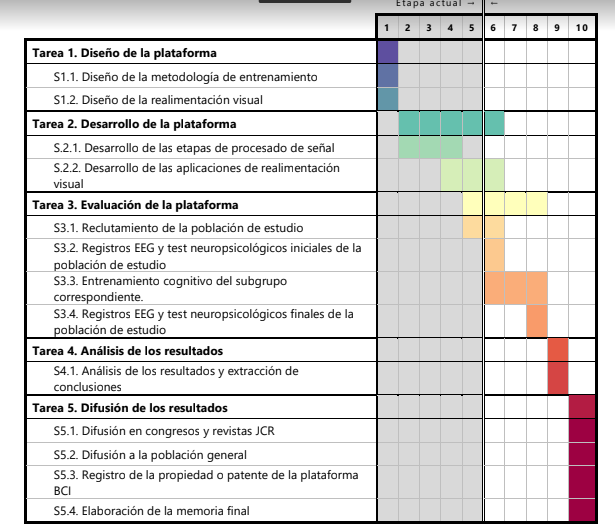
References
Bullmore, Ed and Olaf Sporns. 2009. “Complex Brain Networks: Graph Theoretical Analysis of Structural and Functional Systems.” Nature Reviews Neuroscience 10(3):186.
Cappelletti, Marinella, Hwee Ling Lee, Elliot D. Freeman, and Cathy J. Price. 2009. “The Role of Right and Left Parietal Lobes in the Conceptual Processing of Numbers Marinella.” Journal of Cognitive Neuroscience 22(2):331–46.
Enriquez-Geppert, Stefanie, René J. Huster, Christian Figge, and Christoph S. Herrmann. 2014. “Self-
Regulation of Frontal-Midline Theta Facilitates Memory Updating and Mental Set Shifting.” Frontiers in Behavioral Neuroscience 8:1–13.
Enriquez-Geppert, Stefanie, René J. Huster, and Christoph S. Herrmann. 2017. “EEG-Neurofeedback as a Tool to Modulate Cognition and Behavior: A Review Tutorial.” Frontiers in Human Neuroscience 11(February):1–19.
Fodor, Jerry A. 1983. The Modularity of Mind. MIT press.
Gomez-Pilar, Javier, Rebeca Corralejo, Luis F. Nicolas-Alonso, Daniel Álvarez, and Roberto Hornero. 2016. “Neurofeedback Training with a Motor Imagery-Based BCI: Neurocognitive Improvements and EEG Changes in the Elderly.” Medical and Biological Engineering and Computing 54(11):1655–66.
Hsueh, Jen Jui, Tzu Shan Chen, Jia Jin Chen, and Fu Zen Shaw. 2016. “Neurofeedback Training of EEG Alpha
Rhythm Enhances Episodic and Working Memory.” Human Brain Mapping 37(7):2662–75.
McIntosh, Anthony Randal. 1999. “Mapping Cognition to the Brain through Neural Interactions.” Memory 7(5–6):523–48.
Ros, Tomas, Abele Michela, Anne Bellman, Philippe Vuadens, Arnaud Saj, and Patrik Vuilleumier. 2017.
“Increased Alpha-Rhythm Dynamic Range Promotes Recovery from Visuospatial Neglect: A Neurofeedback Study.” Neural Plasticity 2017:1–9.
Scharnowski, Frank, Chloe Hutton, Oliver Josephs, Nikolaus Weiskopf, and Geraint Rees. 2012. “Improving
Visual Perception through Neurofeedback.” Journal of Neuroscience 32(49):17830–41.
Vernon, David, Tobias Egner, Nick Cooper, Theresa Compton, Claire Neilands, Amna Sheri, and John
Gruzelier. 2003. “The Effect of Training Distinct Neurofeedback Protocols on Aspects of Cognitive Performance.” International Journal of Psychophysiology 47(1):75–85.
Wolpaw, Jonathan and Elizabeth Winter Wolpaw. 2012. Brain-Computer Interfaces: Principles and Practice.
OUP USA.
Zoefel, Benedikt, René J. Huster, and Christoph S. Herrmann. 2011. “Neurofeedback Training of the Upper
Alpha Frequency Band in EEG Improves Cognitive Performance.” NeuroImage 54(2):1427–31.








